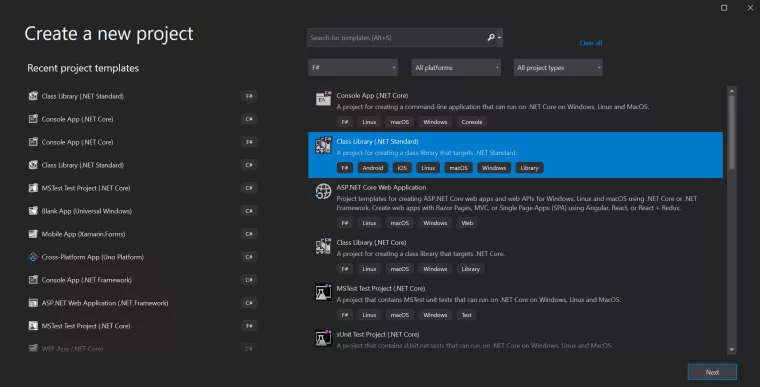Quick Overview:
The .NET capabilities are not limited to C# and F# programming languages. They extend to high-end scripting languages and development techs that help you streamline business operations. The blog aids you in looking into all such factors and components, supporting .NET integration and making you go beyond the highlighted tech.
Introduction
Whenever it’s about developing a .NET application, you’ll find C# and F# programming languages to be on top. But, they are not the only languages or technologies that .NET offers you to use. The .NET integration features are so advanced that it helps you seamlessly leverage Python, VB, and even WCF.
Here, we are going to explore the .NET integration capabilities that help you go beyond C# and F#.
The Language Diversity in .NET
We all know about the main dotnet programming languages, which are C#, F#, and Visual Basic. However, the list doesn’t end here, as IronPython and IronRuby are also on the list. These languages are only used for supporting some specific components, that’s why they are not so popular or highly preferred.
Therefore, you can integrate a total of five languages together in a dotnet application, which are as listed:
- C#: It’s utilized as the main programming language for defining application logic through its object-oriented structure.
- F#: It gets for leveraging fast computation processing, asynchronous programming, and parallel process execution.
- Visual Basic: Used for building interfaces and enabling new applications to integrate with legacy systems based on dotnet technology.
- Iron Python: Preferred for supporting automation, as it extends Python leverages for .NET framework.
- Iron Ruby: It gets utilized due to its flexibility in creating prototypes and fastening the development procedure.
.NET Integration: Ecosystem and Interoperability
The role of common language runtime (CLR) is quite impactful in supporting and ensuring interoperability between different programming languages. It provides the exact environment, components, and tools that lead the languages to reach a certain level where they can understand and interact with each other.
In addition, the shared libraries and cross-platform capability of the programming languages also enable them to work together. Moreover, if we specifically discuss CLR, then common type systems and intermediate languages are the main components that enable .NET integration.
The common type system provides all the protocols to which languages align to ensure type safety. Further, CTS components, such as P/Invoke and COM interop, enable them to inherit functions from each other and even use the libraries.
As a result, code reusability, easy maintainability, and scalability across multiple devices is highly promoted.
A Practical Approach to Understand .NET Integration Features
Now, we are going to undergo the practical procedure of integrating F# and C# in a single .NET project. The implementation is quite easy, even for a beginner, and it’ll provide you with a reference for your real-world projects. It’ll help you understand the process and how you can reference one language into another. You only need to follow the below steps.
1st Step: By using the Visual Studio IDE, create a F# class library project.

2nd Step: While creating the F# project, choose the target as .NET Standard 2.1.

3rd Step: Now, create a new project. But, this time, it’s going to be a C# core console application.

4th Step: From the solution explorer of the C# project, create a reference to the F# class library project.

5th Step: Now, you can use the F# code in your C# project. That’s how simple it is. In a similar way, you can refer to other programming languages and utilize them together.


In addition, you can also convert the entire F# code to C# code within minimal time. Then, you can directly copy-paste it into your C# project. To do this, you first have to compile the F# code and convert it to an intermediate language. Following that, you have to use the “dnSpy” tool to inspect the IL structure and copy-paste it to the desired project.
Real-World Implementation of .NET Integration
The .NET integration features benefit the business at an extended level. Some of the top implementations of .NET integration in the real world are as follows:
1: Cloud-based Development: The .NET languages are able to integrate with all significant cloud service platforms, including AWS, Google Cloud, and MZ Azure. It helps you to deploy the application on a cloud server, leading to saving money and effort and providing maximum uptime, data security, and enhanced productivity.
2: Web Development: With the interoperability of dotnet programming languages, .NET developers are able to build all required features in a web application. For instance, F# code gets utilized in a real-time C# application using the SignalR library. It helps to boost the performance and efficiently process data. Further, Iron Python can also be used for automating tasks based on real-time data.
3: Machine Learning and AI Development: For ML and AI purposes, Iron Python is mostly utilized with C# languages. .NET allows the integration of these languages, helping businesses to leverage fraud detection, user experience enhancement, real-time data analytics, and more.
Concluding Up
From all the details, it’s concluded that .NET is not limited to C# and F#. It gets extended to Iron Python, VB, and Iron Ruby, which helps businesses leverage automation, better application performance, and improved computation. In addition, .NET also aids you in connecting apps with different cloud platforms and web technologies, leading to the embedding of ML and AI capabilities in your software solution. Therefore, .NET is way beyond only F# and C#.
Expert in Software & Web App Engineering
Parag Mehta, the CEO and Founder of Positiwise Software Pvt Ltd has extensive knowledge of the development niche. He is implementing custom strategies to craft highly-appealing and robust applications for its clients and supporting employees to grow and ace the tasks. He is a consistent learner and always provides the best-in-quality solutions, accelerating productivity.






